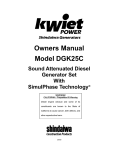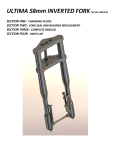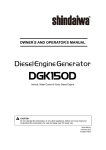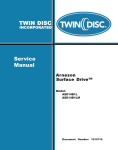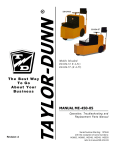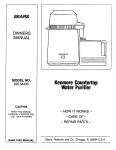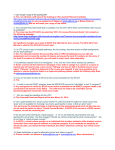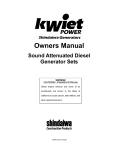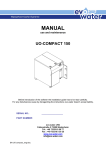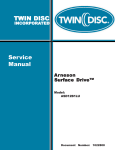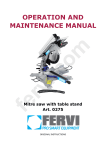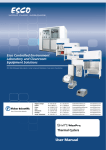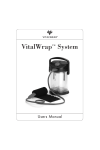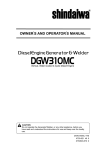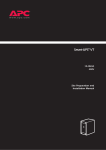Download DGK150D Owners Manual - kWiet Power Generators
Transcript
DGK150D Owners Manual Sound Attenuated Diesel Generator Sets WARNING! CALIFORNIA – Proposition 65 Warning Diesel engine exhaust and some of its constituents are known to the State of California to cause cancer, birth defects, and other reproductive harm. 8/22/06 Part No. 81583 Table of Contents 1. INTRODUCTION ----------------------------------------------------------------------------------------3 2. SAFETY GUIDELINES --------------------------------------------------------------------------------4 3. LABELS ---------------------------------------------------------------------------------------------------6 4. SPECIFICATION ----------------------------------------------------------------------------------------8 5. OUTLINE DRAWINGS --------------------------------------------------------------------------------9 5.1 Control Panel --------------------------------------------------------------------------------------------------- 10 5.2 Main Terminal Board ------------------------------------------------------------------------------------------ 11 5.3 Receptacle Panel ---------------------------------------------------------------------------------------------- 12 6. EQUIPMENT ------------------------------------------------------------------------------------------- 13 6.1 Monitor Displays ----------------------------------------------------------------------------------------------- 13 Coolant Temperature Monitoring Lamp -------------------------------------------------------------------- 13 Engine Oil Monitoring Lamp ---------------------------------------------------------------------------------- 14 Battery Charge Monitoring Lamp ---------------------------------------------------------------------------- 14 Diagnosis Lamp-------------------------------------------------------------------------------------------------- 15 Boost Temperature Lamp-------------------------------------------------------------------------------------- 15 Over Speed Lamp ----------------------------------------------------------------------------------------------- 16 6.2 Meters and Gauges ------------------------------------------------------------------------------------------- 16 Hour Meter -------------------------------------------------------------------------------------------------------- 16 Volt Meter---------------------------------------------------------------------------------------------------------- 16 Ammeter ----------------------------------------------------------------------------------------------------------- 16 Frequency Meter------------------------------------------------------------------------------------------------- 16 Coolant Temperature Gauge---------------------------------------------------------------------------------- 17 Oil Pressure Gauge --------------------------------------------------------------------------------------------- 17 Fuel Gauge (Optional)------------------------------------------------------------------------------------------ 17 6.3 Lamps and Lights ---------------------------------------------------------------------------------------------- 17 Glow Lamp -------------------------------------------------------------------------------------------------------- 17 Pilot Lamp --------------------------------------------------------------------------------------------------------- 17 Panel Light -------------------------------------------------------------------------------------------------------- 17 6.4 Switches --------------------------------------------------------------------------------------------------------- 18 Start Switch ------------------------------------------------------------------------------------------------------- 18 Voltmeter Selector Switch ------------------------------------------------------------------------------------- 18 Ammeter Selector Switch-------------------------------------------------------------------------------------- 18 Voltage Selector Switch ---------------------------------------------------------------------------------------- 19 Panel Light Toggle Switch ------------------------------------------------------------------------------------- 19 Emergency Stop Switch---------------------------------------------------------------------------------------- 19 6.5 Output Circuit Breaker ---------------------------------------------------------------------------------------- 19 6.6 Voltage Adjustment Rheostat ------------------------------------------------------------------------------- 19 6.7 Fuel Directional Valve (Optional)--------------------------------------------------------------------------- 20 6.7.1 Using Fuel From The Internal Tank --------------------------------------------------------------------- 20 6.7.2 Using Fuel From The External Fuel Tank-------------------------------------------------------------- 21 6.7.3 Fuel Directional Valve Location -------------------------------------------------------------------------- 22 Shindaiwa Construction Products 1 7. LIFTING, TRANSPORTING, AND INSTALLING---------------------------------------------- 22 7.1 Lifting ------------------------------------------------------------------------------------------------------------- 22 7.2 Transporting----------------------------------------------------------------------------------------------------- 23 7.3 Installing --------------------------------------------------------------------------------------------------------- 23 8. CONNECTING CABLES---------------------------------------------------------------------------- 24 9. INITIAL STARTUP AND PRE-CHECKS -------------------------------------------------------- 27 9.1 Checking Engine Oil ------------------------------------------------------------------------------------------ 27 9.2 Selecting the Proper Engine Oil---------------------------------------------------------------------------- 28 9.3 Checking Engine Coolant ----------------------------------------------------------------------------------- 28 9.3.1 Checking Radiator Level/ Adding Coolant --------------------------------------------------------- 29 9.3.2 Checking the Coolant Reservoir Tank Level/ Adding Coolant -------------------------------- 29 9.4 Checking the Fan Belt---------------------------------------------------------------------------------------- 29 9.4.1 Tension ----------------------------------------------------------------------------------------------------- 30 9.4.2 Condition--------------------------------------------------------------------------------------------------- 30 9.5 Checking the Fuel Level ------------------------------------------------------------------------------------- 30 9.6 Checking for Leaks-------------------------------------------------------------------------------------------- 30 9.7 Checking the Batteries --------------------------------------------------------------------------------------- 31 10. OPERATION------------------------------------------------------------------------------------------ 31 10.1 Starting --------------------------------------------------------------------------------------------------------- 31 10.2 Loading the Generator-------------------------------------------------------------------------------------- 32 10.3 Operating the Generator ----------------------------------------------------------------------------------- 32 10.4 Stopping the Generator------------------------------------------------------------------------------------- 32 10.5 Automatic Shutdowns and Alarms ----------------------------------------------------------------------- 33 10.6 Connecting to an External Fuel Tank ------------------------------------------------------------------- 34 11. MAINTENANCE ------------------------------------------------------------------------------------- 35 11.1 Oil Change----------------------------------------------------------------------------------------------------- 37 Frequency--------------------------------------------------------------------------------------------------------- 37 Procedure --------------------------------------------------------------------------------------------------------- 37 11.2 Oil Filter Change --------------------------------------------------------------------------------------------- 37 Frequency--------------------------------------------------------------------------------------------------------- 37 Procedure --------------------------------------------------------------------------------------------------------- 37 11.3 Cleaning/Changing the Air Filter Element -------------------------------------------------------------- 37 Frequency--------------------------------------------------------------------------------------------------------- 37 Procedure --------------------------------------------------------------------------------------------------------- 37 11.4 Cleaning/Changing the Fuel Filter ----------------------------------------------------------------------- 38 Frequency--------------------------------------------------------------------------------------------------------- 38 Procedure --------------------------------------------------------------------------------------------------------- 38 11.5 Draining Water From the Internal Fuel Tank----------------------------------------------------------- 38 Frequency--------------------------------------------------------------------------------------------------------- 38 Procedure --------------------------------------------------------------------------------------------------------- 38 11.6 Changing Engine Coolant---------------------------------------------------------------------------------- 38 Frequency--------------------------------------------------------------------------------------------------------- 38 Procedure --------------------------------------------------------------------------------------------------------- 38 12. LONG TERM STORAGE PROCEDURES---------------------------------------------------- 39 13. TROUBLESHOOTING----------------------------------------------------------------------------- 40 Shindaiwa Construction Products 2 1. Introduction Thank you for purchasing a Shindaiwa Kwiet Power Sound Attenuated Diesel Generator. • • • • This user’s manual was created to help ensure the safe operation of this equipment. The manufacturer of this equipment strongly recommends that the user follow all of the instructions contained within this manual to avoid unnecessary accidents or repairs. Operate this equipment only after thoroughly reviewing and understanding the contents of this manual. This manual should always be kept on or near the generator. The battery or batteries supplied with the generator are dry when shipped. Dilute sulfuric acid must be added. The following convention will be used throughout this manual to indicate various degrees of cautions. May cause severe injuries or death. May cause minor injuries or damage to the equipment or other property. Other types of caution. • Even some of the items noted in follow all items and safety guidelines. may lead to severe injuries. Read and carefully Shindaiwa Construction Products 3 2. Safety Guidelines Suffocation from exhaust fumes • Exhaust fumes from the engine on this diesel generating set contain many elements that have been proven to be harmful to humans. Do not operate this equipment in poorly ventilated areas such as inside a room or in a tunnel. • Do not direct exhaust fumes toward people or buildings. Electrical Shock • Do not come in contact with or allow anything else to come in contact with the output terminals during operation. • Be sure to place the protective covers over the output terminals and fasten them securely while operating this equipment. • Do not insert metal objects (such as pins or wires) into plug-in receptacles. • Do not touch the wiring or any electrical or electronic parts inside the equipment during operation. • There is always a danger of being electrocuted by a short-circuit to ground. Be sure to test the generator’s insulation resistance to ground periodically. • Before connecting or disconnecting load cables from the output terminals, always turn the output circuit breaker to the OFF position, stop the engine, and remove the engine key. The person performing the cable disconnect should always keep the key. • Before performing any equipment check or maintenance, stop the engine, and remove the engine key. The person performing the check or maintenance should always keep the key. Injuries • To avoid injuries by unintentional contact with the cooling fan or fan belt, close and lock all doors while operating this equipment. • When lifting the equipment, always use the installed lifting hook. The lifting hook is designed to lift only the generator. Do not lift any additional added weight such as fuel tanks and/or trailers. Injuries to eyes and skin • Battery fluid contains diluted sulfuric acid. Avoid contact with eyes, skin or clothing. If contact with the acid does occur, especially with the eyes, flush immediately with large volumes of water and contact a physician. Fire • This equipment uses diesel (a flammable liquid) as a fuel. When refueling, always stop the engine, and maintain an adequate distance from flames or spark producing devices. Always wait until the engine cools down before refueling. • Always immediately wipe up any diesel fuel or engine oil that is spilled. Do not use this equipment if there are any leaks. Repair the equipment before further use. • Temperatures around the muffler and exhaust piping can get extremely high. Keep any flammable items (such as fuel, gas, paint, etc.) away from these areas. Shindaiwa Construction Products 4 • The battery may emit highly explosive gases. Never expose it to flames or spark producing devices. • This equipment must be operated only on flat surfaces and at least 3 feet away from any obstructions (such as walls) that could hinder airflow. • Do not connect the AC output to any indoor wiring without an approved disconnecting device between the generator and the building’s electrical service. Burns • To avoid sustaining burns from hot vapor, do not open the radiator cap while operating or immediately after stopping this equipment. • Due to extremely high temperatures, do not touch the engine or muffler while operating or immediately after stopping the equipment. • When checking or changing engine oil, always stop the engine, and wait until the engine cools down. Opening either the line to the oil gauge or the oil filler cap during operation may cause severe burns due to hot oil. Injuries • Do not use the tie downs for lifting. They are not designed to hold the weight of the equipment and using them for lifting may cause the equipment to fall. • Always place the equipment on a flat and stable surface to keep it from sliding. • When starting the engine, disconnect the supplied load and set the output circuit breaker to the OFF position. • Do not move the equipment during operation. • When performing equipment checks and/or maintenance, always stop the engine. Do not operate this equipment if it is being modified or if any parts have been removed. WARNING KEEP TERMINAL BLOCK FREE OF DUST AND MOISTURE AT ALL TIMES!! Always keep environmental contaminants such as dust and moisture from building up on the terminal block and generator control box or arcing from the terminals to the generator control box or terminal block mounting screws may result. Shindaiwa Construction Products 5 3. Labels Caution, Danger, Warning and Operation Information Labels: Make sure all information labels are undamaged and readable. Immediately replace damaged or missing information labels. New labels are available from your local authorized Shindaiwa distributor or dealer. 1. Serial Number Plate 50980-00890 11. Striping Label 19407-00073 2. kWiet Power Label 19406-00089 12. Danger-Lifting Hook 19402-00210 3. kWiet Power Label 19406-00108 13. General Safety 19402-00306 4. kWiet Power Label 19406-00109 14. Oil Drain 19401-00154 5. Shindaiwa Label 19420-00096 15. Fuel Drain 19401-00155 6. 150 kVA Label 50980-00880 16. Cooling Water Drain 19401-00242 7. Striping Label 19407-00066 17. Fuel Inlet (Optional) 19401-00243 8. Striping Label 19407-00072 18. Fuel Return (Optional) 19401-00244 9. Striping Label 19407-00073 19. 3-Way Valves (Optional) 19401-00372 10.Striping Label 19407-00074 20. Diesel Fuel Only Shindaiwa Construction Products 6 19401-00251 1. Generator Name Plate 50980-00870 12. Pilot Lamp 19401-00210 2. Voltage Adjust Rheostat 19401-00214 13. Auto Start (Optional) 19407-00055 3. Off-L1-L2-L3-Off 19401-00259 14. Main Circuit Breaker 19401-00235 4. Emergency Stop 19401-00210 15. Engine Control 19401-00375 5. Stop-Run-Start 19401-00216 16. EPA Label 50980-00660 6. Glow Lamp 19401-00373 17. Electric Shock 19402-00215 7. Internal Fuel Tank Only 19401-00371 18. Output Position 19401-00308 8. Monitor Lamps Label 19401-00374 19. GM Spec 6277M 19402-00295 9. Ammeter Switch Inst. 19401-00323 20. Voltage Selector 10. Off L1-L2 L2-L3 Switch Caution L3-L1 Off 19401-00258 11.Panel Light 19401-00212 Shindaiwa Construction Products 7 19402-00288 4. Specification Generator Type Alternator Rated Output Voltage – Three phase Voltage – Single phase Single phase - 120V Single phase - 240V Amps Three phase – 208 V Three phase - 240V Three phase - 480V Frequency Rated speed kVA kW V V A A A A A Hz rpm Winding Power factor Insulation class Excitation No. of poles Type Model (Manufacturer) No. of Cylinders ( bore x stroke ) Continuous rated output Rated speed Displacement in./mm hp rpm cu. in./liters Combustion system Engine Meters Voltage Regulation Speed Regulation Shutdowns Warning Unit Sound Level Cooling method Lubricating method Starting method Fuel Lubricant oil Fuel tank capacity Lubricant volume Cooling water volume Battery capacity Voltage/Frequency/Amperage/Hour Automatic Voltage Regulator Adjustable +6% to -15% gal./liters gal./liters gal./liters V-AH Revolving Field Brushless AC 150 120 208, 220, 240,416, 440, 480 120, 127, 139, 240, 254, 277 361 x 2 (zigzag) 361 (zigzag) 416 361 180 50/60 1800 3-phase, 4-wire Star with neutral / Zig-zag .8 F Static (brushless) 4 Vertical Water-cooled 4-cycle Diesel Engine 6HK1TC (ISUZU) EPA-3 6 (4.53X4.92/115x125) 190 1800 475.4/7.790 Direct Injection, Turbo, Inter-cooler Radiator Forced lubrication Electric Diesel CD class or higher 74/280 9.9/38 6.2/23.8 12V (2) -100AH +/- 1% (no load to full load) +/-.25% Oil pressure, Water temperature Battery Charge Dimensions (L x W x H) Dry weight No Load Full Load in./mm lbs./kg Shindaiwa Construction Products 8 Lamp indication with shutdown Lamp indication 135.8x48.8x72.81/ 3450x1240x1850 6834/3100 59dBA 60dBA 5. Outline Drawings Shindaiwa Construction Products 9 5.1 Control Panel 1. Main Circuit Breaker 11. Ammeter Selector Switch 2. Pilot Light 12. Voltage Adjust Rheostat 3. Panel Light 13. Monitor Lights 4. Voltmeter 14. Hour meter 5. Ammeter 15. Water Temperature Gauge 6. Frequency Meter 16. Oil Pressure Gauge 7. Auto Start Panel (Optional) 17. Fuel Meter (Optional) 8. Auto Start Switch (Optional) 18. Glow Plug Lamp 9. Panel Light Switch 19. Emergency Stop Switch 10. Voltmeter Selector Switch 20. Ignition Switch Shindaiwa Construction Products 10 5.2 Main Terminal Board Shindaiwa Construction Products 11 5.3 Receptacle Panel Note: All duplex receptacles are GFCI protected and are rated at 20 amps. All Twist Loc receptacles are rated at 50 amps. Shindaiwa Construction Products 12 6. Equipment 6.1 Monitor Displays This diesel generator set is equipped with monitoring functions for coolant temperature, oil pressure, battery charge condition, diagnosis, boost temperature, and over speed. Under normal operating conditions, these monitoring lamps will come on momentarily when the engine is first started but will go off very shortly thereafter. If an abnormal condition is detected in coolant temperature or oil pressure, the corresponding monitor lamp will flash and the automatic shutdown will be activated. This will cause the engine to shut down. Insufficient battery charging will cause the light to flash only. The diagnosis lamp flashes but does not shut the engine down if the electronic control module detects a fault that could affect engine operation. The boost temperature lamp flashes but does not shut the engine down if there is an excessive temperature at the inlet to the intake manifold. The over speed light flashes and shuts the engine down on an over speed condition. If an automatic shutdown is activated, check for and correct the cause of the shutdown prior to trying to restart the generator set. Coolant Temperature Monitoring Lamp Injuries • To avoid injuries by unintentional contact with the cooling fan and/or fan belts, close and lock all doors while operating this equipment. Burns • To avoid sustaining burns from hot vapor, do not open the radiator cap while operating or immediately after stopping this equipment. • Due to extremely high temperatures, do not come in contact with the engine and/or muffler while operating or immediately after stopping this equipment. If the coolant temperature reaches 212º Fahrenheit increasing during operation, the coolant temperature monitoring lamp will flash, and the automatic shutdown will activate. If this occurs, check the coolant reservoir tank, and replenish coolant if needed (refer to 9.3 Checking Engine Coolant). If the coolant level is normal, check for a loose fan belt or possible water leak in the cooling system. Always allow the engine to cool down prior to making these checks. Shindaiwa Construction Products 13 • If the coolant level is too low, the temperature sensor cannot detect the coolant temperature. Always check the water level in the radiator and the coolant reservoir tank prior to operating this equipment. Engine Oil Monitoring Lamp Injuries • To avoid injuries by unintentional contact with the cooling fan and/or fan belts, close and lock all doors while operating this equipment. Burns • Due to extremely high temperatures, do not come in contact with the engine and/or muffler while operating or immediately after stopping this equipment. • When checking or changing engine oil, always stop the engine and wait until the engine cools down. Opening either the line to the oil gauge or the oil filler cap during operation may cause injury due to hot oil. If the engine oil pressure drops below 10 psi during operation, the oil pressure monitoring lamp will flash, and the automatic shutdown will activate. If this occurs, check the engine oil level, and fill to the maximum level if needed. • The oil pressure sensor cannot detect engine oil degradation due to extended use. Oil change intervals listed under section 11 must be strictly adhered to. Battery Charge Monitoring Lamp Insufficient battery charge during operation will cause the battery charge monitoring lamp to flash. If this occurs, check the condition and tightness of the fan belt and replace or tighten if necessary. • • For changing the belt, refer to the engine Workshop Manual. The Battery Charge Monitor cannot detect the degradation of battery life or the battery fluid level (refer to 9.7 Checking the Battery). Shindaiwa Construction Products 14 Diagnosis Lamp Injuries • To avoid injuries by unintentional contact with the cooling fan and/or fan belts, close and lock all doors while operating this equipment. Burns • Due to extremely high temperatures, do not come in contact with the engine and/or muffler while operating or immediately after stopping this equipment. • When checking or changing engine oil, always stop the engine and wait until the engine cools down. Opening either the line to the oil gauge or the oil filler cap during operation may cause injury due to hot oil. If the electronic control module detects a fault that could affect engine operation it will flash the diagnosis lamp to indicate that further diagnosis as to the source of fault is necessary. This will not shut the engine down. Investigate and correct the cause of the diagnosis lamp. Boost Temperature Lamp Injuries • To avoid injuries by unintentional contact with the cooling fan and/or fan belts, close and lock all doors while operating this equipment. Burns • Due to extremely high temperatures, do not come in contact with the engine and/or muffler while operating or immediately after stopping this equipment. • When checking or changing engine oil, always stop the engine and wait until the engine cools down. Opening either the line to the oil gauge or the oil filler cap during operation may cause injury due to hot oil. If the inlet temperature to the inlet manifold exceeds 185° F the boost temperature lamp will flash but will not shut the engine down. Investigate and correct the reason for the excessive temperature. Shindaiwa Construction Products 15 Over Speed Lamp Injuries • To avoid injuries by unintentional contact with the cooling fan and/or fan belts, close and lock all doors while operating this equipment. Burns • Due to extremely high temperatures, do not come in contact with the engine and/or muffler while operating or immediately after stopping this equipment. • When checking or changing engine oil, always stop the engine and wait until the engine cools down. Opening either the line to the oil gauge or the oil filler cap during operation may cause injury due to hot oil. If the electronic control module detects that engine speed has exceeded 2070 rpm it will flash the over speed lamp and will shut the engine down. Investigate the cause and correct before trying to restart the engine. 6.2 Meters and Gauges Hour Meter The hour meter keeps track of run time. This meter should be used to schedule preventive maintenance. Note: The hour meter will continue to operate as long as the start switch is in the ON position, regardless of whether the engine is actually running or not. Volt Meter The volt meter displays the voltage output from the generator. The voltage displayed will be dependent on the position of the voltage selector switch. For single-phase operation it will display L1 or L3 voltage only. Ammeter The amp meter displays the electrical current output from the generator. The amperage displayed will be dependent on the position of the amp meter selector switch. For single-phase operation it will display L1 or L3 phase amperage only. Frequency Meter The frequency meter will display the frequency of the generated power. Shindaiwa Construction Products 16 Coolant Temperature Gauge This gauge indicates the temperature of the engine coolant in degrees Fahrenheit. normal operating conditions this gauge should read approximately 180 °F to 200 °F. Under Oil Pressure Gauge This gauge indicates the oil pressure of the engine in pounds per square inch. Under normal operating conditions this gauge should read approximately 40 to 60 pounds per square inch. Fuel Gauge (Optional) This gauge indicates the fuel level in the internal fuel tank only. If there is an external fuel tank being used to supply fuel to the generator this gauge will not indicate the fuel level of that tank. 6.3 Lamps and Lights Glow Lamp When the start switch is turned to the Run/Preheat position, the Glow Lamp will light to indicate that the glow plugs are energized and preheating the engine cylinders. When the preheating is completed, the lamp will go off, indicating that the engine is ready to be started. • Preheating time may vary from 1 to 5 seconds, depending on the coolant temperature. Pilot Lamp The pilot lamp is located on the generator control panel and indicates whether or not the engine is running. When the lamp is lit the engine is running. When the lamp is not lit the engine is not running. Panel Light The panel light is located on the generator control panel and is used to illuminate the generator and engine control panels. This light is turned on and off with the panel light toggle switch which is also located on the generator control panel next to the panel light. This light can only be energized when the engine is running. Shindaiwa Construction Products 17 6.4 Switches Start Switch The Start Switch is a three position switch that is used for starting, stopping, and preheating the engine. POSITIONS: STOP: When the switch is set to this position, all power will be off. The switch must be set to this position to remove the key. Run/Preheat:: The switch must be set to this position during operation. This position is also used to preheat the glow plugs and for removing air from the fuel lines. • Do not leave the switch in this position, while the engine is stopped. It may drain the battery. START: This position allows the user to start the engine. When the operator releases the key while in this position, the switch will automatically return to the Operating/Preheating position. Voltmeter Selector Switch The voltmeter selector switch is a 5 position switch located on the generator control panel next to the voltmeter. This switch selects which phase voltage the voltmeter will be displaying. There are two off positions for this switch, one at the far left position and one at the far right position. In the off positions the voltmeter will not be displaying any voltage. In the L1-L2 position the voltmeter will display the phase voltage between phase L1 and phase L2. In the L2-L3 position the voltmeter will display the phase voltage between phase L2 and phase L3. In the L3-L1 position the voltmeter will display the phase voltage between phase L3 and phase L1. This switch must be in the L1-L3 position to read single phase voltage. Ammeter Selector Switch The ammeter selector switch is a 5 position switch located on the generator control panel next to the ammeter. This switch selects which phase current the ammeter will be displaying. There are two off positions for this switch, one at the far left position and one at the far right position. In the off positions the ammeter will not be displaying any amperage. In the L1 position the ammeter will display phase L1 current. In the L2 position the ammeter will display phase L2 current. In the L3 position the ammeter will display phase L3 current. This switch must be in the L1 or L3 position to read single phase current. Shindaiwa Construction Products 18 Voltage Selector Switch The voltage selector switch is a lockable 3 position switch located directly above the terminal connection panel. This switch provides a quick, convenient method of changing the generator output voltage. This switch should never be operated while the generator is running. The Three Phase 480/277 position gives an output from the generator of 480 volts three phase or 277 volts single phase. The Three Phase 208/120 position gives an output from the generator of 208 volts three phase with 120 volts single phase or 240 volts three phase with 139 volts single phase. 208 volts or 240 volts three phase are obtained by adjusting the voltage adjust rheostat on the control panel. The Single Phase 240/120 volt position gives a single phase output from the generator of 240 volts or 120 volts. Panel Light Toggle Switch This switch is located on the generator control panel next to the Panel Light. It is used to turn the panel light on and off. To prevent leaving this light on and draining the battery, this switch can only turn the Panel Light on when the generator is running. Emergency Stop Switch This switch is located just to the left of the start/stop switch on the engine control panel. It is a red momentary contact type switch that must be held in until the engine completely stops. 6.5 Output Circuit Breaker The Output Circuit Breaker is located on the control panel and is used for connecting and disconnecting the load from the output of the generator. Turning the circuit breaker to the ON position will allow power to be supplied to the load. Turning the circuit breaker to the OFF position will remove all power from the load. The breaker will also trip and remove power from the load in the event that there is an overload condition on the generator or if the terminal board cover is opened while the generator is running. 6.6 Voltage Adjustment Rheostat The Voltage Adjustment rheostat is used to adjust the generated output voltage of the generator. Turning the voltage adjust knob clockwise will increase the generated voltage. Turning the voltage adjust knob counter-clockwise will decrease the generated voltage. The adjustment range available with this knob is plus 6.5% and minus 15%. Shindaiwa Construction Products 19 6.7 Fuel Directional Valve (Optional) Burns • Always stop the engine prior to performing any work on fuel lines. • Immediately wipe up any fuel leakage. The fuel directional valve provides a quick and convenient method of using an external fuel tank as a fuel supply for the engine. If an external fuel supply is being used, the internal fuel tank is not available as a supply of fuel for the engine. 6.7.1 Using Fuel From The Internal Tank The Fuel Directional Valve is set to the Internal Tank position when the equipment is shipped. This position allows the fuel from the internal tank to be used as a fuel source for the engine. In addition, both the external fuel intake and the external fuel return lines are plugged with 3/8 inch pipe plugs. Always ensure that the external fuel intake and return are plugged with the supplied plugs or is connected to an external fuel tank while using the internal fuel tank as the fuel source. Always set the fuel directional valve to the internal tank position and cover the external fuel intake and fuel return ports with the supplied plugs, whenever the internal fuel tank is being used as the fuel source. Fuel Directional Valve Instruction Label Shindaiwa Construction Products 20 Fuel Directional Valve in the Internal Tank Position (Using Internal Fuel Tank) 6.7.2 Using Fuel From The External Fuel Tank Connect hoses from the external fuel tank to the external fuel intake and the external fuel return ports, and set the Fuel Directional valve to the external fuel tank position. You can now supply fuel from the external fuel tank. For detailed instructions, (refer to Section 10.6 Connecting to an External Fuel Tank). Fuel Directional Valve in the External Tank Position (Using External Fuel Tank) Shindaiwa Construction Products 21 6.7.3 Fuel Directional Valve Location The Fuel Directional Valve is located directly behind the radiator and is mounted to the bottom of the enclosure 7. Lifting, Transporting, and Installing • The lifting hook is designed to lift only the generator. Do not lift any additional added weight such as fuel tanks and/or trailers with the lifting hook. Injuries • Use only the installed lifting hook for lifting this equipment. • Do not use the tie down posts for lifting. They are not designed to hold the weight of this equipment. 7.1 Lifting Always use the installed lifting hook, whenever lifting this equipment. This lifting hook is designed to lift only the generator. Do not lift any additional added weight such as fuel tanks and/or trailers with this lifting hook. Do not lift with the tie downs. Shindaiwa Construction Products 22 7.2 Transporting When transporting this equipment, make sure that the equipment is properly secured using the tie down posts. • Always use extreme care when loading, unloading, and transporting this equipment. Failure to do so may result in damages to and/or malfunction of the equipment. 7.3 Installing Suffocation from exhaust fumes • Exhaust fumes from the engine on this equipment contain many elements that have been proven to be harmful to humans. Do not operate this equipment in poorly ventilated areas such as inside a room or in a tunnel. • Do not direct exhaust fumes toward pedestrians or buildings. Fire • This equipment must be operated only on flat surfaces and at least 3 feet away from any obstructions (such as walls) that could hinder airflow. • Temperatures around the muffler and exhaust piping can get extremely high. Keep any flammable items (such as fuel, gas, paint, etc.) away from these areas. • • • This equipment must be operated on a hard and flat surface. Operating under any other conditions may result in damage to or malfunctions of the equipment. Do not block the airflow from the radiator output or muffler exhaust. This may result in reduced engine performance, overheating, or other significant damage. Operating in abnormally dusty, salty or high particulate environments may result in fouling of the radiator or air cleaner. The frequency of maintenance and operating checks should be increased when operating this equipment in these types of environments. Shindaiwa Construction Products 23 8. Connecting Cables Electrical Shock • Before connecting or disconnecting load cables from the output terminals, always turn the output circuit breaker to the OFF position, stop the engine, and remove the engine key. The person performing the connection or disconnection should always keep the key. Cable connection Terminal Board (3-phase/single phase) 480 Volt Three Phase and 277 Volt Single Phase Switch Position Shindaiwa Construction Products 24 208 Volt Three Phase and 120 Volt Single Phase Switch Position Shindaiwa Construction Products 25 240 Volt Single Phase and 120 Volt Single Phase Switch Position Note: Place the voltmeter selector switch in the L3-L1 position and the ammeter selector switch in the L1 or L3 position when the Voltage Selector Switch is in the 1 Phase 240/120V position. Shindaiwa Construction Products 26 9. Initial Startup and Pre-Checks Electrical Shock • Prior to performing any equipment check or maintenance, stop the engine and remove the engine key. The person performing the equipment check or maintenance should always keep the key. Burns • Prior to performing any engine checks or adjustments, stop the engine. Wait until the engine cools down, before performing any checks or adjustments. Fire • Always immediately wipe up any spilled or dripped fuel or oil. If a leak is found, do not use this equipment until the cause of the leak has been determined and remedied. Complete repairs to the equipment before further use. 9.1 Checking Engine Oil (Also, please refer to the accompanying Instruction Manual for the engine) When checking the engine oil, be sure to keep the equipment level and insert the dipstick fully. Prior to starting the engine, make sure to fill the engine oil to the MAX line through the oil filler tube. • • If the equipment is not level, you cannot obtain an accurate oil level reading. Do not overfill the engine with oil. Too much engine oil could damage the engine. 1. Remove the dipstick from the crankcase and wipe it clean with a clean cloth. 2. Reinsert it fully and then gently remove it again. 3. Check the oil level on the dipstick. The level must be between the “Max” level mark and the “Min” level mark. 4. If the level is above the “Max” mark, drain oil until the level is at or below the “Max” level mark. 5. If the level is at or below the “Min” level mark, add oil until the level is above the “Min” level mark. Shindaiwa Construction Products 27 9.2 Selecting the Proper Engine Oil Use engine oil specifically designed for diesel engine use with the proper viscosity based on the anticipated ambient temperature (refer to the chart below). Oil Viscosity and Temperature Temperature °F -22° 5° 32° 60° 77° 86° SAE10W-30 SAE10W SAE30W SAE20/20W SAE40W SAE 15W-40/20W-40 • Use API class CD grade or higher engine oil. 9.3 Checking Engine Coolant (Also, please refer to the accompanying Instruction Manual for the engine) Injuries • Prior to performing any equipment check or maintenance, stop the engine, and remove the engine key. The person performing the equipment check or maintenance should always keep the key. Burns • To avoid sustaining burns from hot vapor, do not open the radiator cap while operating or immediately after stopping this equipment. • Due to extremely high temperatures, do not touch the engine or muffler while operating or immediately after operation of this equipment. Shindaiwa Construction Products 28 9.3.1 Checking Radiator Level/ Adding Coolant (Also, please refer to the accompanying Instruction Manual for the engine) 1. Remove the radiator cap and check the level of the coolant by observing the level in the radiator filler port. The coolant level should be up to the filler port neck. If not, add coolant. The coolant should be a 50/50 mix of GM SPEC 6277M or equivalent long life Coolant/Water. 2. Fill the radiator with coolant until it reaches the filler port neck. Fill slowly to prevent air entry. 3. Reinstall the radiator cap and tighten. 4. Recheck the level after a few minutes of running the engine and add additional coolant if necessary. 9.3.2 Checking the Coolant Reservoir Tank Level/ Adding Coolant (Also, please refer to the accompanying Instruction Manual for the engine) 1. Ensure the coolant level is between the MIN and the MAX line. 2. If the coolant level is low, add the same mixture of coolant used in the radiator to fill the reservoir tank to the MAX line. • • Always use potable water when mixing coolant. Do not spill antifreeze or engine coolant on the exhaust system or hot engine parts. Under some conditions the long life coolant is combustible. 9.4 Checking the Fan Belt (Also, please refer to the accompanying Instruction Manual for the engine) Injuries • Before performing any equipment check or maintenance, stop the engine, and remove the engine key. The person performing the equipment check or maintenance should always keep the key. • To avoid injuries by unintentional contact with the cooling fan or fan belt, close and lock all doors while operating this equipment. Burns Due to extremely high temperatures, do not touch the engine or muffler while operating or immediately after stopping the equipment. Shindaiwa Construction Products 29 9.4.1 Tension The fan belt should have ¼ to ½ inch slack when applying finger pressure at the midpoint between the fan pulley and the alternator pulley. 9.4.2 Condition Check the fan belt for any damage and replace if necessary. • Refer to the Instruction Manual for the engine to adjust or replace the fan belt. 9.5 Checking the Fuel Level Fire • Always immediately wipe up any diesel fuel or engine oil that is spilled. Do not use this equipment if there are any leaks. Repair the equipment before further use. Prior to starting the engine check the level of the fuel in the tank that is currently supplying fuel. The fuel gauge on the control panel shows only the level of the fuel in the internal tank. If an external fuel tank is connected and being used as the fuel source, the fuel level in this tank is monitored and read separately from the gauge on the control panel. • • Ensure the fuel strainer is installed in the neck of the fill spout. Fill the tank to slightly less than the FULL mark. 9.6 Checking for Leaks Fire • Do not use this equipment if there are any leaks. Repair the equipment before further use. • Check all hose connections for leakage. Prior to starting the engine make a complete and thorough inspection of the engine to ensure there are no fuel leaks. Shindaiwa Construction Products 30 9.7 Checking the Batteries Injuries to eyes and skin • Battery fluid contains diluted sulfuric acid. Avoid contact with eyes, skin or clothing. If contact with the acid does occur, especially with the eyes, immediately flush with large volumes of water, and contact a physician. Fire • The battery may emit highly explosive gases. Never expose it or the surrounding area to flames or spark producing devices. 10. Operation Suffocation from exhaust fumes • Exhaust fumes from the engine on this diesel generating set contain many elements that have been proven to be harmful to humans. Do not operate this equipment in poorly ventilated areas such as inside a room or in a tunnel. • Do not direct exhaust fumes toward pedestrians or buildings. Fire • Temperatures around the muffler and exhaust piping can get extremely high. Keep any flammable items (such as fuel, gas, paint, etc.) away from these areas. • This equipment must be operated only on flat surfaces and at least 3 feet away from any obstructions (such as walls) that could hinder airflow. Injuries • Always place the equipment on a flat and stable surface to keep it from sliding. • Before starting the engine, turn off the connected equipment and turn the generator output circuit breaker to the OFF position. 10.1 Starting 1. 2. 3. 4. Turn the output circuit breaker on the control panel to the OFF position. Turn the starter switch to the Start position. As soon as the engine starts, release the starter switch. In cold temperatures, turn the starter switch to the Operating/Preheat position until the preheat lamp turns on and then turn it to the Start position. • • • Preheating time may vary from 1 to 5 seconds. Do not crank the starter motor for more than 10 seconds at a time. If the engine does not start, wait at least 30 seconds before retrying. 5. After the engine starts, ensure all the monitor lamps remain off. 6. Run the engine at idling speed without load for at least 10 minutes. Shindaiwa Construction Products 31 10.2 Loading the Generator 1. Set the required voltage using the voltage adjusting knob. 2. Turn the generator output circuit breaker to the ON position to apply power to the load terminals. Electrical Shock • Before connecting or disconnecting load cables from the output terminals, always turn the output circuit breaker to the OFF position, stop the engine, and remove the engine key. The person performing the cable connection or disconnection should always keep the key. 10.3 Operating the Generator 1. 2. In the event the generator output breaker trips OFF, make the necessary correction or repair (or decrease the load) prior to resetting the breaker by first turning it to the OFF position, and then back to the ON position. When any RED warning monitor lamp turns ON, stop operation immediately and correct the fault before resuming operation. 10.4 Stopping the Generator 1. Turn the load breaker(s) to the OFF position. 2. Turn the generator output circuit breaker to the OFF position and allow the engine to run at idling speed for about 3 minutes for cooling down. 3. Turn the starter switch to the STOP position. Shindaiwa Construction Products 32 10.5 Automatic Shutdowns and Alarms This generator is equipped with automatic shutdowns and alarms. These shutdowns and alarms activate automatically with display in the event of an abnormal situation. If an automatic stop device has activated, turn the starter switch to the STOP position. Correct the cause(s) of the automatic shutdown prior to trying to restart the generator. If an alarm occurs correct the cause of the alarm. If the cause of the alarm cannot be corrected shut the engine down and investigate and correct the cause of the alarm prior to restarting the engine. Automatic Shutdown List No. Symptoms Monitor Lamp 1 High Coolant Temperature 2 3 Circuit Breaker OFF Action Automatic Engine Alarm Lamp Shutoff Flash Cause Engine coolant temperature is too high (activates at 212 º F increasing) -- X X Low Oil Pressure -- X X Engine oil pressure too low (activates at 10 psi decreasing) Insufficient Charge -- -- X When the battery can no longer hold a charge 4 Diagnosis X 5 High Boost Temperature X 6 Over Speed X Shindaiwa Construction Products 33 X Some abnormal condition has occurred that requires special diagnostic software for analysis When turbocharger air inlet temperature exceeds 185° F increasing When engine speed exceeds 2070 rpm increasing 10.6 Connecting to an External Fuel Tank • • Stop the engine prior to commencing external fuel tank connections. Always immediately wipe up any diesel fuel or engine oil that is spilled. Do not use this equipment if there are any leaks. Repair the equipment before further use. 1. Turn the Fuel Directional valve to the internal tank position (see Page 19) . 2. Disconnect the 3/8 inch pipe plugs from both the external fuel intake and the external fuel return lines and connect the hoses from the external fuel tank, ensuring that the suction and return are connected to the proper plugs. 3. Turn the Fuel Directional valve to the external tank position (see Page 19). 4. Remove the air from the connected hoses by positioning the starter switch to the Operating/Preheat position and holding it there for approximately 10 to 15 seconds. This will allow the use of the fuel from the external fuel tank. • • To avoid leaks from the external fuel intake or the external fuel return ports, always turn the 3-way valve to the internal tank position while connecting or disconnecting the external fuel tank lines. Use extreme caution when connecting the external fuel tank lines. If the 3-way valve is not set properly, fuel may leak from either the internal fuel tank or the external fuel tank. Shindaiwa Construction Products 34 11. Maintenance Electrical Shock • Before performing any equipment check or maintenance, stop the engine, and remove the engine key. The person performing the equipment check or maintenance should always keep the key. Burns • To avoid sustaining burns from hot vapor, do not open the radiator cap while operating or immediately after stopping this equipment. • Due to extremely high temperatures, do not touch the engine or muffler while operating or immediately after stopping this equipment. • When checking or changing engine oil, always stop the engine, and wait until the engine cools down. Opening either the line to the oil gauge or the oil filler cap during operation may cause injury due to hot oil. Fire • Always immediately wipe up any diesel fuel or engine oil that is spilled. Do not use this equipment if there are any leaks. Repair the equipment before further use. To maximize the useful life of this generator, follow the recommended periodic equipment and maintenance checks according to the following table. The hour meter should be used as a guide for actual operating time. • • • • With the exception of the pre-startup and operating checks, only qualified technicians should perform the equipment and maintenance checks. Maintenance items marked with XX should be referred to the nearest authorized dealer. This chart covers only basic checks and maintenance for the engine. For more detailed maintenance information for the engine refer to the Instruction Manual for the engine. For maximum performance and useful life, always use genuine replacement parts. Shindaiwa Construction Products 35 Startup Check Engine Description Engine oil check / add oil Engine oil change Oil Filter change Coolant level check / add coolant Change PCV Filter Exhaust color check Every 200 hrs Every 400 hrs X X X X Every 500 hrs Every 1000 hrs Every 2000 hrs X X X X Coolant change X or 1 yr. Clean or replace fuel filter Drain water from fuel tank Clean inside fuel tank Leak check (fuel, oil, and coolant) Replace fuel hose X X XX X XX or 1 yr. Clean or replace air cleaner element Battery fluid level check Battery hydrometer check Fan belt check Flush Radiator Check and adjust engine valve clearance Compression check Fuel injection nozzle check Fuel injection timing check X Clean X Replace X X X XX XX XX XX XX Generator Meters, gauges and alarm lamps Insulation test X X or 1 yr. Shindaiwa Construction Products 36 11.1 Oil Change Frequency First time Thereafter 500 hours Every 500 hours Procedure 1. Remove the oil fill cap. 2. Loosen the engine oil drain plug and allow the oil to drain completely. 3. Reinstall the drain plug. 4. Add oil to the Max line on the dipstick (approximately 2quarts). Do not overfill. 5. Reinstall the filler cap hand-tight. Use only engine oil designated API CC grade or higher. 11.2 Oil Filter Change Frequency First time Thereafter 500 hours Every 500 hours Procedure 1. Drain the engine oil completely, as described in section 11.1. 2. Using an oil filter wrench, loosen and remove the oil filter. 3. Lightly coat the rubber gasket of the new oil filter with some of the new engine oil. 4. Screw the new filter into place and hand tighten it until the gasket just contacts the filter seat. Then, using an oil filter wrench, give it additional 3/4 turn to seat the filter. 5. Add oil and reinstall the filler cap. 11.3 Cleaning/Changing the Air Filter Element Frequency Clean Replace Every 200 hours Every 500 hours Procedure 1. Unscrew the wing nut and remove the filter element. 2. Clean or replace the filter element, and reinstall it. • • In dusty or other high particulate environments, increase the frequency of cleaning. To clean the filter element: • If the element has dried contaminants, it may be cleaned by blowing compressed air through it from the inside. • If the element has any carbon or grease buildup, it should be replaced with a new element. Shindaiwa Construction Products 37 11.4 Cleaning/Changing the Fuel Filter Frequency Clean Replace Every 500 hours Every 500 hours Procedure 1. Remove the outer case of the filter using the filter wrench Isuzu part No. 8-9801-3170-0 2. Remove the fuel filter element. 3. Install the new fuel filter element. 4. Fill the case with clean diesel to help facilitate bleeding the fuel system upon completion. 5. Tighten the case by hand ensuring that the diesel does not leak out. 6. Use the filter wrench and tighten and additional 1/3 to 2/3 turns. 11.5 Draining Water From the Internal Fuel Tank Frequency Drain water Every 200 hours Procedure 1. Unscrew the fuel drain plug. 2. After completely draining any water, reinstall the drain plug. 11.6 Changing Engine Coolant Replace only with GM SPEC 6277M or equivalent long life coolant Frequency Replace 7. 8. 9. 10. Every 2 years or 400 hours Procedure 1. Remove the radiator cap. 2. Loosen the engine coolant/water drain plug. 3. Drain the engine coolant completely. 4. Reinstall the drain plug. 5. Remove the reservoir tank and empty the engine coolant that is in the tank. 6. Reinstall the reservoir tank. Fill the radiator with engine coolant (a 50/50 mix of GM SPEC 6277M or equivalent long life coolant and water) to the top of the filler neck (approximately 1.9 gal). Fill slowly to prevent air entry. Fill the reservoir tank with engine coolant to the Max line. Reinstall the radiator cap. Recheck the level after a few minutes of running the engine and refill if necessary. Shindaiwa Construction Products 38 12. Long Term Storage Procedures Electrical Shock • Before performing any equipment check or maintenance, stop the engine, and remove the engine key. The person performing the check or maintenance should always keep the key. Fire • Temperatures around the muffler and exhaust piping can get extremely high. Keep any flammable items (such as fuel, gas, paint, etc.) away from these areas. • Always immediately wipe up any diesel fuel or engine oil that is spilled. Do not use this equipment if there are any leaks. Repair the equipment before further use. If the generator will not be used for more than two months, perform the following maintenance and storage procedures. 1. 2. 3. 4. Remove the battery. Change the engine oil. Drain the fuel from the fuel tank and fuel filter. Clean all parts, cover the generator, and store it away from dust and humidity. • • Recharge the removed battery at least once a month. Refer to the engine instruction manual for detailed care procedures for the engine. Shindaiwa Construction Products 39 13. Troubleshooting Electrical Shock • Do not operate this generator if it is wet. • Before performing any equipment check or maintenance, stop the engine and remove the engine key. The person performing the check or maintenance should always keep the key. Injuries • Before performing any equipment check or maintenance, stop the engine and remove the engine key. The person performing the check or maintenance should always keep the key. Fire • The battery may emit highly explosive gases. Never expose it to flames or spark producing devices. • Temperatures around the muffler and exhaust piping can get extremely high. Keep any flammable items (such as fuel, gas, paint, etc.) away from these areas. Follow the guidelines below when performing any troubleshooting. If you cannot resolve the problem(s) by using this troubleshooting guide, contact the nearest authorized service center. Symptoms Starter motor will not turn over. Starter motor turns over but the engine will not start. Engine starts, but stalls immediately. 1. 2. 1. 2. 1. 2. 3. 1. Cannot turn the circuit breaker to the ON position. 2. 3. Black or white smoke is coming 1. out of the exhaust line. Possible cause Dead battery Weak battery Low fuel Water or contaminants in the fuel. Low oil pressure High coolant temperature Air in the fuel system Circuit breaker has not been completely turned to the OFF position Overload Terminal cover is open. Overloading 1. 2. 1. 2. 1. 2. 3. 1. 2. 3. 1. Shindaiwa Construction Products 40 Corrective Actions Replace the battery Recharge the battery Refill the fuel tank Drain water or clean the fuel tank and fuel filter Check the oil level and fill if necessary Check coolant level and fill if necessary Bleed out the air Turn the circuit breaker to the OFF position and then back to on. Check the load side, reset the thermal overload relay inside the control panel Close and latch the terminal cover Reduce the load Shindaiwa Incorporated 11975 SW Herman Road Tualatin, OR 97062 Phone 503 692-3070 Fax 503 692-6696 www.kwietpower.com 7/25/07 Part No. 80350 Manufactured by Shindaiwa Corporation Hiroshima, Japan











































